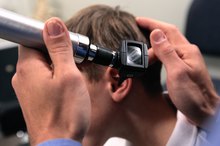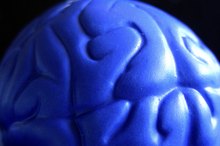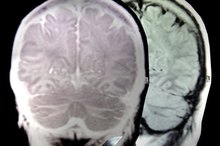Parts of the Brain That Control Sight
Sight is a complex function of the brain that extends from the front to the back of the head. To produce sight, the eyes capture information and send it through the optic nerve to be processed by the occipital lobe. The brain also incorporates other information, such as sensory stimuli, to result in the application of sight, such as picking up an object. Problems with sight, such as vision gaps, can result from damage to specific parts of the brain.
Optic Nerve
When light reaches the retina in the eye and an image is created, it moves to the rest of the brain through the optic nerve. The optic nerve is the second cranial nerve, and is the connection between the brain and eyes. Damage to the optic nerve prevents any information from being sent from the eyes to the rest of the brain. The Canadian Institutes of Health Research states that information from the left eye goes to the right hemisphere and vice versa; this is because the optic nerve crosses at the optic chiasm, causing the optic nerve from each eye to send its information to the opposite side of the brain.
Occipital Lobe
Parts of the Brain Involved With Hearing
Learn More
Once the information passes from the optic nerve to the rest of the brain, it is sent to the occipital lobe, where sight is processed. The occipital lobe is located in the back of the brain, above the cerebellum, and forms the center of the visual perception system, according to the Centre for Neuro Skills. Each hemisphere has its own occipital lobe; therefore, each occipital lobe processes the information sent to that specific hemisphere. The occipital lobe controls how a person perceives sight, so damage to this brain section can result in visual field cuts, and problems identifying color or movement of an object.
Visual Cortex
The last part of the brain involved in sight is the visual cortex, where sensory and motor information is integrated with vision. The Canadian Institutes of Health Research states that multiple visual pathways are involved. For example, the ventral visual pathway controls how a person identifies objects, while the dorsal visual pathway controls a person's visual-motor response to objects. In other words, the visual cortex allows you to realize that you're looking at a plate, for example, and then allows you to pick it up.
Related Articles
References
Writer Bio
Lia Stannard has been writing about women’s health since 2006. She has her Bachelor of Science in neuroscience and is pursuing a doctorate in clinical health psychology.









